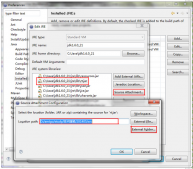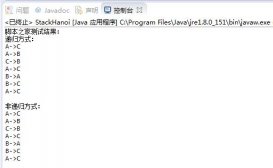本文实例讲述了java对象序列化操作。分享给大家供大家参考,具体如下:
当两个进程在进行远程通信时,彼此可以发送各种类型的数据。无论是何种类型的数据,都会以二进制序列的形式在网络上传送。发送方需要把这个java对象转换为字节序列,才能在网络上传送;接收方则需要把字节序列再恢复为java对象。
只能将支持 java.io.serializable 接口的对象写入流中。每个 serializable 对象的类都被编码,编码内容包括类名和类签名、对象的字段值和数组值,以及从初始对象中引用的其他所有对象的闭包。
概念
序列化:把java对象转换为字节序列的过程。
反序列化:把字节序列恢复为java对象的过程。
用途
对象的序列化主要有两种用途:
1) 把对象的字节序列永久地保存到硬盘上,通常存放在一个文件中;
2) 在网络上传送对象的字节序列。
对象序列化
序列化api
java.io.objectoutputstream代表对象输出流,它的writeobject(object obj)方法可对参数指定的obj对象进行序列化,把得到的字节序列写到一个目标输出流中。只有实现了serializable和externalizable接口的类的对象才能被序列化。
java.io.objectinputstream代表对象输入流,它的readobject()方法从一个源输入流中读取字节序列,再把它们反序列化为一个对象,并将其返回。
代码示例
|
1
2
3
4
5
6
7
8
9
10
11
12
13
14
15
16
17
18
19
20
21
22
23
24
25
26
27
28
29
30
31
32
|
import java.io.*;import java.util.date;public class objectsaver { public static void main(string[] args) throws exception { /*其中的 d:\\objectfile.obj 表示存放序列化对象的文件*/ //序列化对象 objectoutputstream out = new objectoutputstream(new fileoutputstream("d:\\objectfile.obj")); customer customer = new customer("王麻子", 24); out.writeobject("你好!"); //写入字面值常量 out.writeobject(new date()); //写入匿名date对象 out.writeobject(customer); //写入customer对象 out.close(); //反序列化对象 objectinputstream in = new objectinputstream(new fileinputstream("d:\\objectfile.obj")); system.out.println("obj1 " + (string) in.readobject()); //读取字面值常量 system.out.println("obj2 " + (date) in.readobject()); //读取匿名date对象 customer obj3 = (customer) in.readobject(); //读取customer对象 system.out.println("obj3 " + obj3); in.close(); }}class customer implements serializable { private string name; private int age; public customer(string name, int age) { this.name = name; this.age = age; } public string tostring() { return "name=" + name + ", age=" + age; }} |
执行结果

说明
读取对象的顺序与写入时的顺序要一致。
对象的默认序列化机制写入的内容是:对象的类,类签名,以及非瞬态和非静态字段的值。
常见序列化操作
打印流
|
1
2
3
4
5
6
7
8
9
10
11
|
public class hello { public static void main(string[] args) throws exception { file file = new file("e:" + file.separator + "myfile" + file.separator + "test" + file.separator + "123.txt"); outputstream outputstream = new fileoutputstream(file); printstream printstream = new printstream(outputstream); printstream.print(123); printstream.println("hello"); printstream.println(12.5); printstream.close(); }} |
键盘输入读取到程序中
|
1
2
3
4
5
6
7
8
9
10
|
public class hello { public static void main(string[] args) throws exception { inputstream in = system.in; byte[] data = new byte[100]; system.out.println("输入数据:"); int read = in.read(data); system.out.println(read); system.out.println(new string(data,0,read)); }} |
扫码流
|
1
2
3
4
5
6
7
8
9
10
11
|
public class hello { public static void main(string[] args) throws exception { scanner scanner = new scanner(new fileinputstream(new file("e:" + file.separator + "myfile" + file.separator + "test" + file.separator + "123.txt"))); scanner.usedelimiter("\n"); while (scanner.hasnext()){ string next = scanner.next(); system.out.println(next); } scanner.close(); }} |
scanner.usedelimiter("\n");表示以回车(换行)为定界符,回车间为一段扫码的内容。
扫描键盘输入
|
1
|
scanner scanner = new scanner(system.in); |
注意:使用while判断键盘输入,程序可能会无法结束
对象序列化
序列化操作类:objectoutputstream,写到文件中
|
1
2
3
4
5
6
7
8
9
10
11
12
13
14
15
16
17
18
19
20
21
22
23
24
25
26
27
28
29
30
31
32
33
34
35
36
37
|
public class hello { public static void main(string[] args) throws exception { a a = new a("hello", 123); file file = new file("e:" + file.separator + "myfile" + file.separator + "test" + file.separator + "a.ser"); outputstream outputstream = new fileoutputstream(file); objectoutputstream objectoutputstream = new objectoutputstream(outputstream); objectoutputstream.writeobject(a); objectoutputstream.close(); }}class a implements serializable { private string title; private integer number; public a(string title, integer number) { this.title = title; this.number = number; } public string gettitle() { return title; } public void settitle(string title) { this.title = title; } public integer getnumber() { return number; } public void setnumber(integer number) { this.number = number; } @override public string tostring() { return "a{" + "title='" + title + '\'' + ", number=" + number + '}'; }} |
实体需要实现可序列化的接口implements serializable,表示一种能力
反序列化操作类:objectinputstream,读到程序里
|
1
2
3
4
5
6
7
8
9
|
public class hello { public static void main(string[] args) throws exception { file file = new file("e:" + file.separator + "myfile" + file.separator + "test" + file.separator + "a.ser"); inputstream inputstream = new fileinputstream(file); objectinputstream objectinputstream = new objectinputstream(inputstream); a a = (a) objectinputstream.readobject(); system.out.println(a); }} |
transient关键字,实体的属性使用该关键子,进行序列化时该属性值将不会被保存,反序列化的结果为,该属性的值为该属性类型的默认值。
|
1
2
|
private string title;private transient integer number; |
希望本文所述对大家java程序设计有所帮助。
原文链接:https://blog.csdn.net/shuair/article/details/82013196















